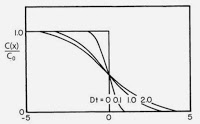| Online: | |
| Visits: | |
| Stories: |

| Story Views | |
| Now: | |
| Last Hour: | |
| Last 24 Hours: | |
| Total: | |
What My Dogs Forced Me To Learn About Thermal Energy Transfer
I’m a dog lover, so I have to enjoy an American Journal of Physics paper that begins “For many years, I have competed and judged in American Kennel Club obedience trials.” The title of the paper is also delightful: “What my dogs forced me to learn about thermal energy transfer” (Craig Bohren, American Journal of Physics, Volume 83, Pages 443-446, 2015). Bohren’s hypothesis is that an animal perceives hotness and coldness not directly from an object's temperature, as one might naively expect, but from the flux density of thermal energy. I could follow his analysis of this idea, but I prefer to use the 5th edition of Intermediate Physics for Medicine and Biology, because Russ Hobbie and I have already worked out almost all the results we need.
Chapter 4 of IPMB analyzes diffusion. We consider the concentration, C, of particles as they diffuse in one dimension. Initially (t = 0), there exists a concentration difference C0 between the left and right sides of a boundary at x = 0. We solve the diffusion equation in this case, and find the concentration in terms of an error function
where D is the diffusion constant. A plot of C(x,t) is shown in Fig. 4.22 (we assume C = 0 on the far right, but you could add a constant to the solution without changing the physics, so all that really matters is the concentration difference).
In homework Problem 19, Russ and I show that the analysis of particle diffusion is equivalent to an analysis of heat conduction, with the thermal diffusivity D given by the thermal conductivity, κ, divided by the specific heat capacity, c, and the density, ρ
So, by analogy, if you start (t = 0) with a uniform temperature on the left and on the right sides of a boundary at x = 0, with an initial temperature difference ΔT between sides, the temperature distribution T(x,t) is (to within a additive constant temperature) the same as the concentration distirbution calculated earlier.
The temperature of the interface is always ΔT/2. If a dog responded to simply the temperature at x = 0 (where its thermoreceptors are presumably located), it would react in a way strictly proportional to the temperature difference ΔT. But Bohren’s hypothesis is that thermoreceptors respond to the energy flux density, κ dT/dx.
Now let us look again at Fig. 4.22. The slope of the curve at x = 0 is the key quantity. So, we must differentiate our expression for T(x,t). We get
By the chain rule, this becomes (with u = x/√4Dt)
The derivative of the error function is given in IPMB on page 179
At the interface (u = 0), this becomes 2/√π. Therefore
Bohren comes to the same result, but by a slightly different argument.
The energy flux density depends on time, with an infinite response initially (we assume an abrupt difference of temperature on the two sides of the boundary x = 0) that falls to zero as the time becomes large. The flux density depends on the material parameters by the quantity κ/√D , which is equivalent to √cρκ and is often called the thermal inertia.
Bohren goes on to analyze the case when the two sides have different properties (for example, the left might be a piece of aluminum, and the right a dog’s tongue), and shows that you get a similar result except the effective thermal inertia is a combination of the thermal inertia on the left and right. He does not solve the entire bioheat equation (Sec. 14.11 in IPMB), including the effect of blood flow. I would guess that blood flow would have little effect initially, but it would play a greater and greater role as time goes by.
Perhaps I will try Bohren’s experiment: I’ll give Auggie (my daughter Kathy’s lovable foxhound) a cylinder of aluminum and a cylinder of stainless steel, and see if he can distinguish between the two. My prediction is that, rather than either metal, he prefers rawhide.
Source: http://hobbieroth.blogspot.com/2015/05/what-my-dogs-forced-me-to-learn-about.html




